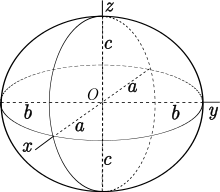Theorem of the three geodesics
In differential geometry the theorem of the three geodesics states that every Riemannian manifold with the topology of a sphere has three closed geodesics that form simple closed curves without self-intersections. [1] [2] The result can also be extended to quasigeodesics on a convex polyhedron.
History and proof

This result stems from the mathematics of ocean navigation, where the surface of the earth can be modeled accurately by an ellipsoid, and from the study of the geodesics on an ellipsoid, the shortest paths for ships to travel. In particular, a nearly-spherical triaxial ellipsoid has only three simple closed geodesics, its equators.[3] In 1905, Henri Poincaré conjectured that every smooth surface topologically equivalent to a sphere likewise contains at least three simple closed geodesics,[4] and in 1929 Lazar Lyusternik and Lev Schnirelmann published a proof of the conjecture, which was later found to be flawed.[5]
One proof of this conjecture examines the homology of the space of smooth curves on the sphere, and uses the curve-shortening flow to find a simple closed geodesic that represents each of the three nontrivial homology classes of this space.[2]
Generalizations
More strongly, there necessarily exist three simple closed geodesics whose length is at most proportional to the diameter of the surface.[6]
The number of closed geodesics of length at most L on a smooth topological sphere grows in proportion to L/log L, but not all such geodesics can be guaranteed to be simple.[7]
On compact hyperbolic Riemann surfaces, there are infinitely many simple closed geodesics, but only finitely many with a given length bound. They are encoded analytically by the Selberg zeta function. The growth rate of the number of simple closed geodesics, as a function of their length, was investigated by Maryam Mirzakhani.[8]
Non-smooth metrics
| | Unsolved problem in computer science: Is there an algorithm that can find a simple closed quasigeodesic on a convex polyhedron in polynomial time? (more unsolved problems in computer science) |
It is also possible to define geodesics on some surfaces that are not smooth everywhere, such as convex polyhedra. Although some polyhedra have simple closed geodesics (for instance, the regular tetrahedron and disphenoids have infinitely many closed geodesics, all simple)[9][10] others do not. In particular, a simple closed geodesic of a convex polyhedron would necessarily bisect the total angular defect of the vertices, and almost all polyhedra do not have such bisectors.[3][9]
Nevertheless, the theorem of the three geodesics can be extended to convex polyhedra by considering quasigeodesics, curves that are geodesic except at the vertices of the polyhedra and that have angles less than π on both sides at each vertex they cross. A version of the theorem of the three geodesics for convex polyhedra states that all polyhedra have at least three simple closed quasigeodesics; this can be proved by approximating the polyhedron by a smooth surface and applying the theorem of the three geodesics to this surface.[11] It is an open problem whether any of these quasigeodesics can be constructed in polynomial time.[12][13]
References
- ↑ Klingenberg, Wilhelm (1985), "The existence of three short closed geodesics", Differential geometry and complex analysis, Springer, Berlin, pp. 169–179, MR 780043.
- 1 2 Grayson, Matthew A. (1989), "Shortening embedded curves" (PDF), Annals of Mathematics, Second Series, 129 (1): 71–111, doi:10.2307/1971486, MR 979601.
- 1 2 Galperin, G. (2003), "Convex polyhedra without simple closed geodesics" (PDF), Regular & Chaotic Dynamics, 8 (1): 45–58, doi:10.1070/RD2003v008n01ABEH000231, MR 1963967.
- ↑ Poincaré, H. (1905), "Sur les lignes géodésiques des surfaces convexes" [Geodesics lines on convex surfaces], Transactions of the American Mathematical Society (in French), 6 (3): 237–274, doi:10.2307/1986219, JSTOR 1986219.
- ↑ Lyusternik, L.; Schnirelmann, L. (1929), "Sur le problème de trois géodésiques fermées sur les surfaces de genre 0" [The problem of three closed geodesics on surfaces of genus 0], Comptes Rendus de l'Académie des Sciences de Paris (in French), 189: 269–271.
- ↑ Liokumovich, Yevgeny; Nabutovsky, Alexander; Rotman, Regina (2014), Lengths of three simple periodic geodesics on a Riemannian 2-sphere, arXiv:1410.8456
 .
. - ↑ Hingston, Nancy (1993), "On the growth of the number of closed geodesics on the two-sphere", International Mathematics Research Notices (9): 253–262, doi:10.1155/S1073792893000285, MR 1240637.
- ↑ Mirzakhani, Maryam (2008), "Growth of the number of simple closed geodesics on hyperbolic surfaces", Annals of Mathematics, 168 (1): 97–125, doi:10.4007/annals.2008.168.97, MR 2415399, Zbl 1177.37036,
- 1 2 Fuchs, Dmitry; Fuchs, Ekaterina (2007), "Closed geodesics on regular polyhedra" (PDF), Moscow Mathematical Journal, 7 (2): 265–279, 350, MR 2337883.
- ↑ Cotton, Andrew; Freeman, David; Gnepp, Andrei; Ng, Ting; Spivack, John; Yoder, Cara (2005), "The isoperimetric problem on some singular surfaces", Journal of the Australian Mathematical Society, 78 (2): 167–197, doi:10.1017/S1446788700008016, MR 2141875.
- ↑ Pogorelov, A. V. (1949), "Quasi-geodesic lines on a convex surface", Matematicheskii Sbornik, N.S., 25(67): 275–306, MR 0031767.
- ↑ Demaine, Erik D.; O'Rourke, Joseph (2007), "24 Geodesics: Lyusternik–Schnirelmann", Geometric folding algorithms: Linkages, origami, polyhedra, Cambridge: Cambridge University Press, pp. 372–375, doi:10.1017/CBO9780511735172, ISBN 978-0-521-71522-5, MR 2354878.
- ↑ Itoh, Jin-ichi; O'Rourke, Joseph; Vîlcu, Costin (2010), "Star unfolding convex polyhedra via quasigeodesic loops", Discrete and Computational Geometry, 44 (1): 35–54, arXiv:0707.4258
 , doi:10.1007/s00454-009-9223-x, MR 2639817.
, doi:10.1007/s00454-009-9223-x, MR 2639817.